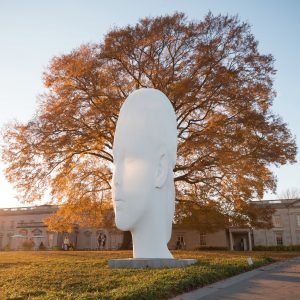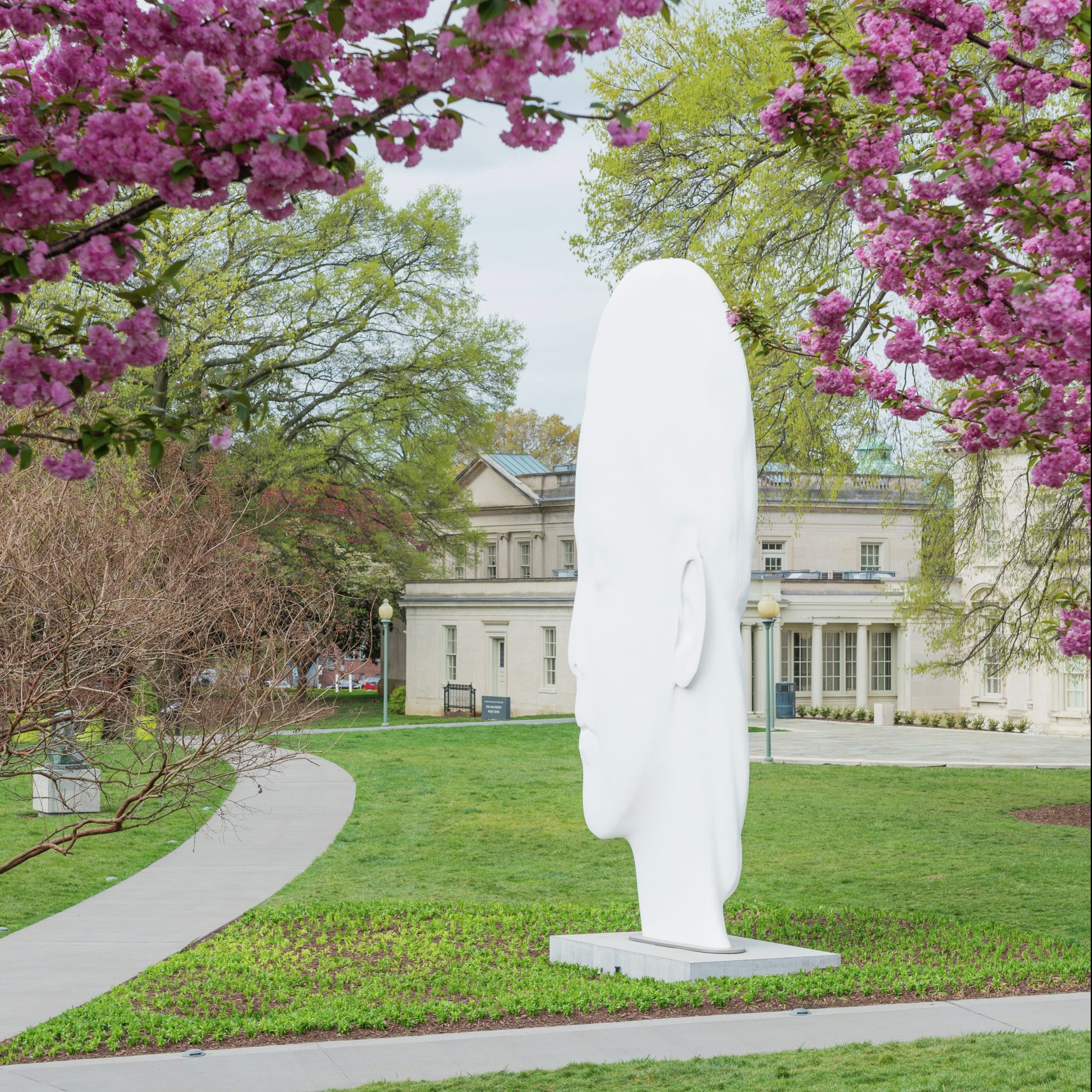
The Conservation of Chloe
The beloved VMFA sculpture, Chloe, will be receiving conservation repairs. Learn more about the process and the sculpture in this resource.
“Beauty is the big connection with all things and with all people, the vast place which contains all our memories. Something we carry anchored in us, an emotion,”-Jaume Plensa
Chloe continues a long series of sculptural heads by world-renowned Spanish artist Jaume Plensa (born 1955) that feature young girls, with closed eyes, whose dream-like qualities transform their surroundings. It has become a beloved icon at VMFA, engaging visitors both young and old. Unveiled in April 2017, Chloe was commissioned by VMFA with endowed funds as part of its strategic plan initiative to add new site-specific pieces to the E. Claiborne and Lora Robins Sculpture Garden.
Watch the installation of Chloe in this video!
The Conservation Process
Chloe is composed of a stainless steel infrastructure surrounded by fiberglass and marble dust, with a protective polyurethane coating. Unfortunately soon after the sculpture was unveiled, the polyurethane coating began to crack and peel off the fiberglass surface. This damage has worsened over time, resulting in a disfigured and structurally compromised surface, particularly along the northwest side of the sculpture’s face. VMFA’s conservation staff worked with the artist’s New York-based gallery, Galerie Lelong and determined that the best way to repair the sculpture and return it to the artist’s aesthetic vision is to completely remove the original polyurethane coating. It will then be replaced with a new protective coating system that the artist has selected. This repair will prevent any further damage to the sculpture and restore its pristine white surface.
Testing Phase
The process of removing the coating from Chloe and reapplying a new surface began this summer with testing to determine the least aggressive abrasive material that will remove the peeling coating without damaging the surface underneath. Five different abrasive materials were tested: corn husks, baking soda, Jet Mag (synthetic olivine), fine grit crushed recycled glass, and medium grit crushed recycled glass.The best abrasive turned out to be medium grit crushed recycled glass. This material is not only highly efficient in removing the coating, it will leave the textured surface underneath fully intact.
Full Execution
The full execution of the repair will be done onsite, with the sculpture surrounded by protective scaffolding and debris netting for about a month. In order to reduce the amount of dust produced and to provide additional levels of pressure control, a vapor blasting technique will be used. Vapor blasting combines the abrasive material with water, thereby reducing the amount of dust by up to 92%, decreasing the amount of abrasive material needed to provide the same level of cleaning and providing the flexibility of variable water pressure. After the failed coating has been removed, the underlying surface will be inspected for any flaws or issues. Once the surface has passed inspection, it will be ready to receive its new protective coating.
New Coating System
The new coating system was proposed by the artist’s studio. It will be a four-part system from Endura Paint, consisting of a primer, sealer, the white color layer, and a UV filtering topcoat.
About Crux Scenica
The repair work on Chloe is being performed by Crux Scenica, a local specialty fabrication workshop. They have experience working with fiberglass sculptures and have a deep understanding of the layering structure and physical and mechanical properties of the materials. They are also knowledgeable about the system that will be used to recoat the sculpture. Crux Scenica has done other work for VMFA including fabrication for It’s Egypt in the Art Education Gallery, the painting of the east well entryway for Sunken Cities, and set design work in the Cheek Theater. Crux Scenica was founded by sculptors Joshua Bennett and Christina Delli Santi to bring ideas into reality, no matter how simple or complex, by combining creativity, technical prowess, and craftsmanship.
Website: www.cruxscenica.com
FAQs
Why is the current coating cracking and peeling?
While the exact cause is under investigation, the current polyurethane coating may have been poorly formulated. Polyurethane coatings are known for their durability and ability to create robust surfaces that withstand weathering, corrosion, and scratching. Unexpectedly, the coating on Chloe is expanding and contracting in response to water, dew, and elevated humidity. As a result, cracks and peeling are occurring on the more shady side of the sculpture where it takes longer for the sculpture to dry after it rains or dew forms on the surface. Polyurethane that has been formulated properly would not respond to water or moisture in this way.
Why do you have to remove all of the coating? Can’t you just treat the spots that are cracking and peeling?
While some areas of the coating appear to be firmly attached, it is highly likely that they will start to crack as time goes on. Removing the entire coating and replacing it all at the same time will produce the most stable surface and beautiful outcome. This also is the approach that the artist wants us to take to help preserve his vision for the piece.
About the Artist
Over his 30-year career, Catalan artist Jaume Plensa has had exhibitions and commissions in more than 20 countries, from Japan to Brazil. He is perhaps best known in the United States for his 50-foot Crown Fountain, which has served as an iconic destination in Chicago’s Millennium Park for more than a decade. In summer 2010, Plensa gained critical recognition for his successful six-month installation in New York’s Madison Square Garden of a 44-foot sculpture of a 9-year-old girl, Echo, now installed permanently at the Seattle Art Museum’s Olympic Sculpture Garden. More recently, Plensa exhibited his work at the 2015 Venice Biennale, as well as at the Frist Center for the Visual Arts in Nashville, Tennessee, which organized the comprehensive Jaume Plensa: The Human Landscape exhibition that traveled in 2016.
Learn more from the artist in this video!

